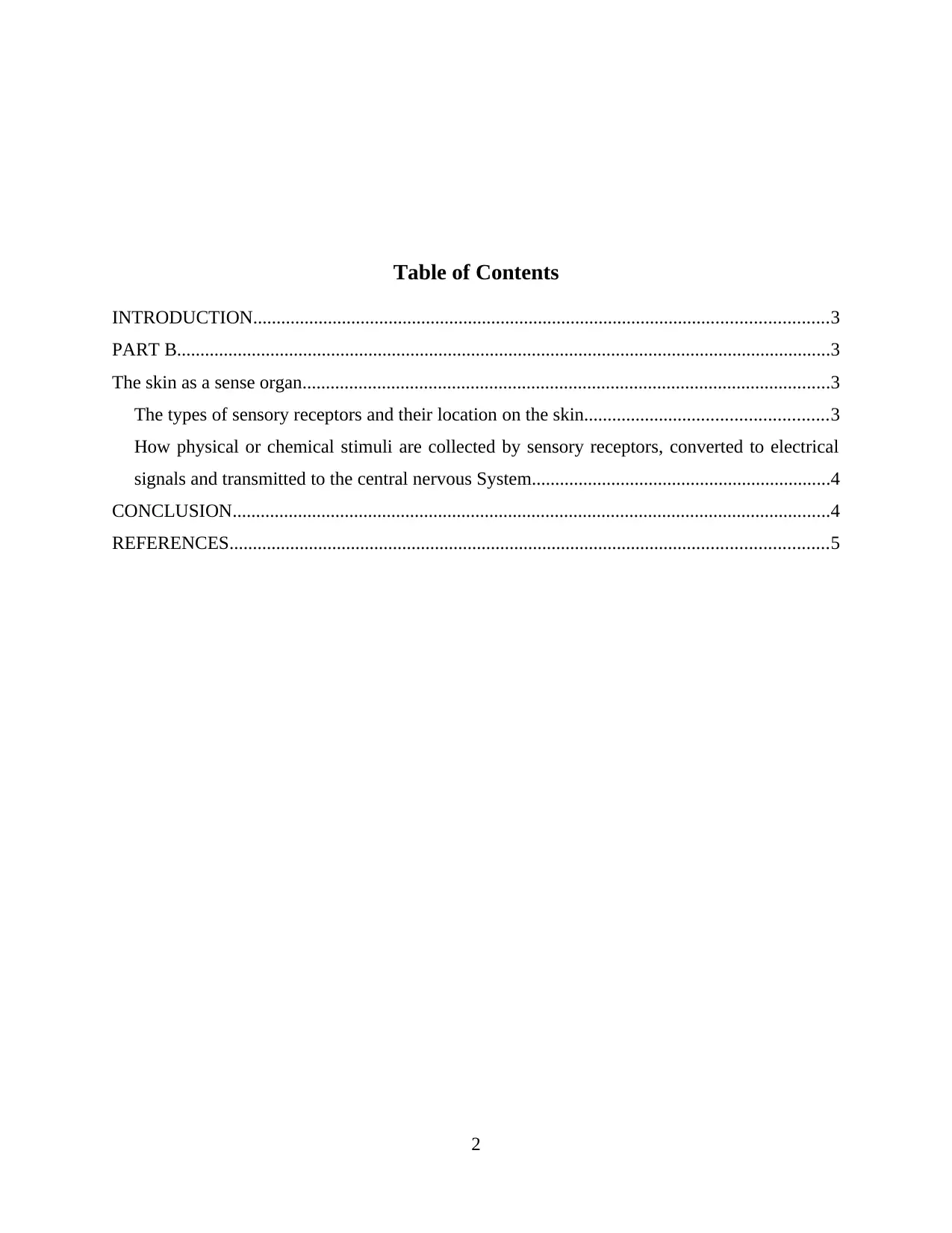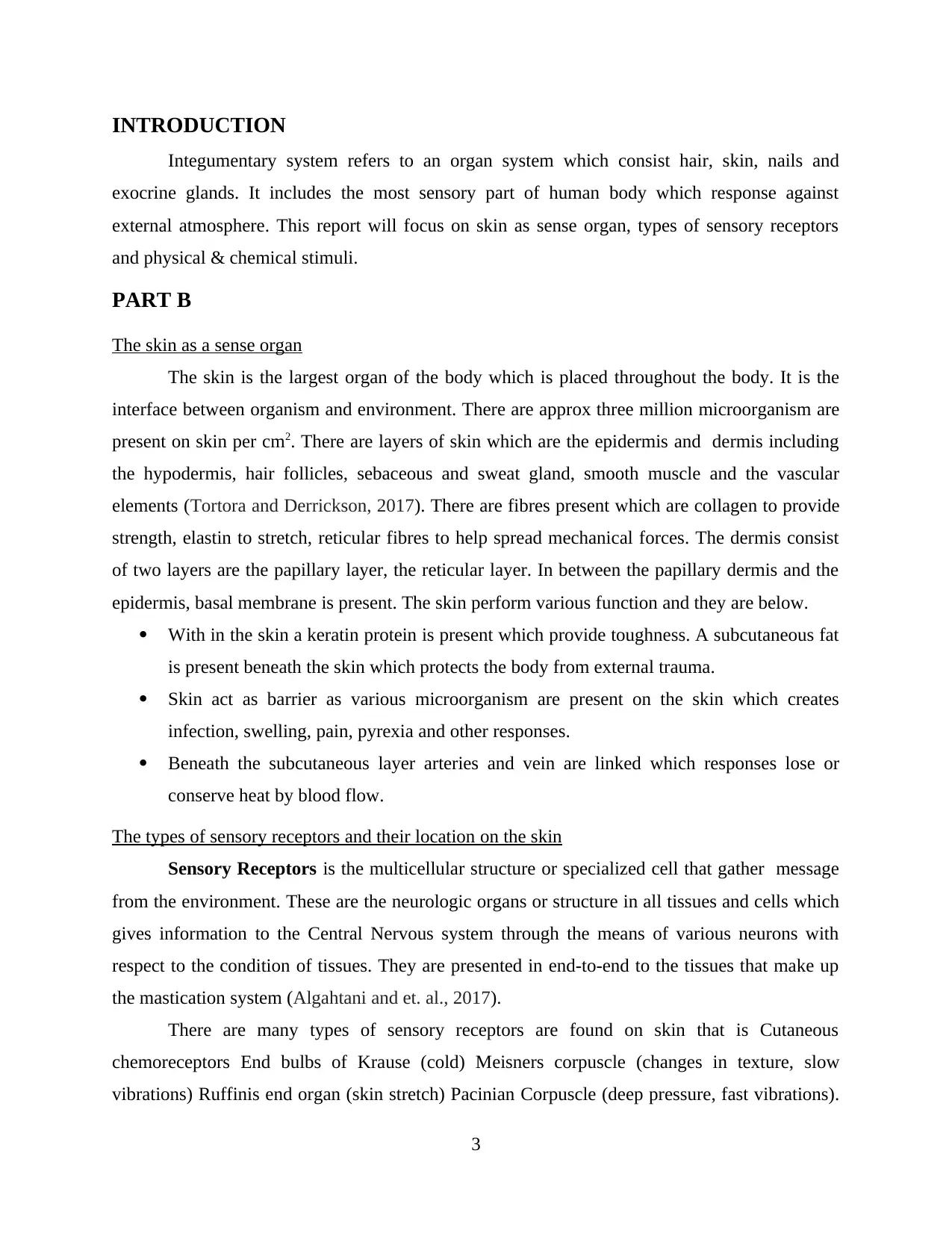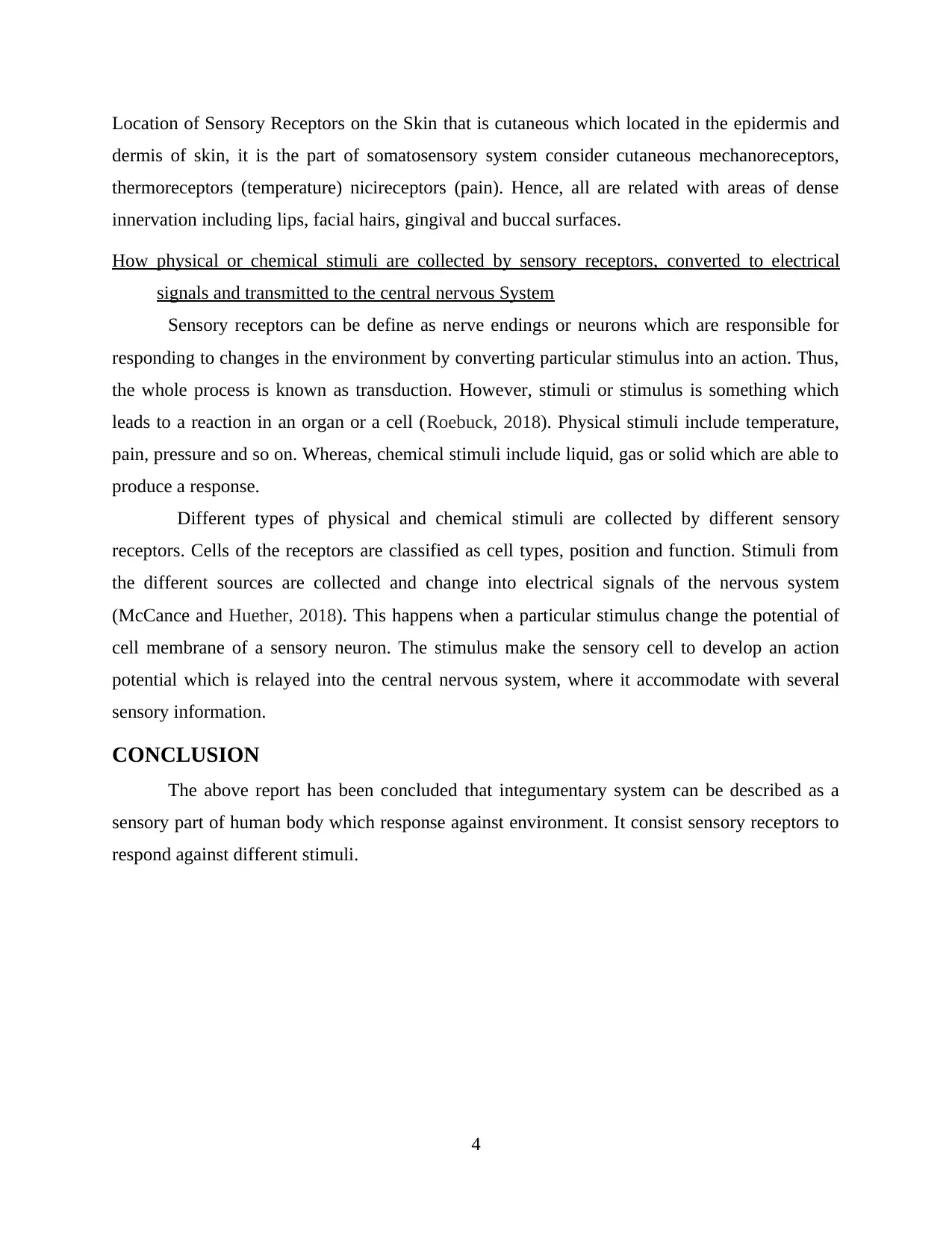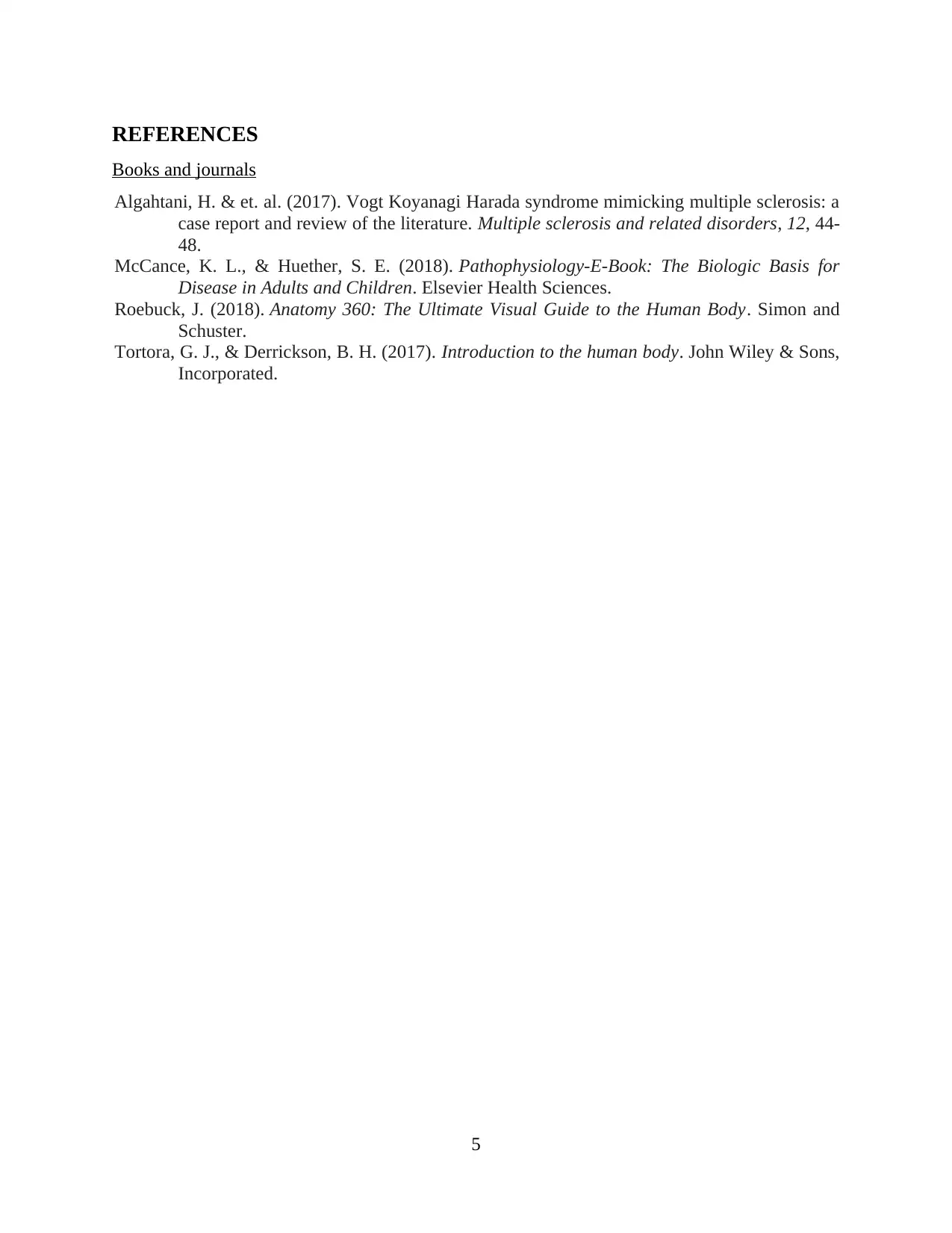The Integumentary And Nervous System
VerifiedAdded on 2023/01/18
|5
|911
|72
AI Summary
This report discusses the integumentary system as a sense organ, the types of sensory receptors on the skin, and how physical and chemical stimuli are collected and transmitted to the central nervous system. It also provides references for further reading.
Contribute Materials
Your contribution can guide someone’s learning journey. Share your
documents today.

The Integumentary And
Nervous System
1
Nervous System
1
Secure Best Marks with AI Grader
Need help grading? Try our AI Grader for instant feedback on your assignments.

Table of Contents
INTRODUCTION...........................................................................................................................3
PART B............................................................................................................................................3
The skin as a sense organ.................................................................................................................3
The types of sensory receptors and their location on the skin....................................................3
How physical or chemical stimuli are collected by sensory receptors, converted to electrical
signals and transmitted to the central nervous System................................................................4
CONCLUSION................................................................................................................................4
REFERENCES................................................................................................................................5
2
INTRODUCTION...........................................................................................................................3
PART B............................................................................................................................................3
The skin as a sense organ.................................................................................................................3
The types of sensory receptors and their location on the skin....................................................3
How physical or chemical stimuli are collected by sensory receptors, converted to electrical
signals and transmitted to the central nervous System................................................................4
CONCLUSION................................................................................................................................4
REFERENCES................................................................................................................................5
2

INTRODUCTION
Integumentary system refers to an organ system which consist hair, skin, nails and
exocrine glands. It includes the most sensory part of human body which response against
external atmosphere. This report will focus on skin as sense organ, types of sensory receptors
and physical & chemical stimuli.
PART B
The skin as a sense organ
The skin is the largest organ of the body which is placed throughout the body. It is the
interface between organism and environment. There are approx three million microorganism are
present on skin per cm2. There are layers of skin which are the epidermis and dermis including
the hypodermis, hair follicles, sebaceous and sweat gland, smooth muscle and the vascular
elements (Tortora and Derrickson, 2017). There are fibres present which are collagen to provide
strength, elastin to stretch, reticular fibres to help spread mechanical forces. The dermis consist
of two layers are the papillary layer, the reticular layer. In between the papillary dermis and the
epidermis, basal membrane is present. The skin perform various function and they are below.
With in the skin a keratin protein is present which provide toughness. A subcutaneous fat
is present beneath the skin which protects the body from external trauma.
Skin act as barrier as various microorganism are present on the skin which creates
infection, swelling, pain, pyrexia and other responses.
Beneath the subcutaneous layer arteries and vein are linked which responses lose or
conserve heat by blood flow.
The types of sensory receptors and their location on the skin
Sensory Receptors is the multicellular structure or specialized cell that gather message
from the environment. These are the neurologic organs or structure in all tissues and cells which
gives information to the Central Nervous system through the means of various neurons with
respect to the condition of tissues. They are presented in end-to-end to the tissues that make up
the mastication system (Algahtani and et. al., 2017).
There are many types of sensory receptors are found on skin that is Cutaneous
chemoreceptors End bulbs of Krause (cold) Meisners corpuscle (changes in texture, slow
vibrations) Ruffinis end organ (skin stretch) Pacinian Corpuscle (deep pressure, fast vibrations).
3
Integumentary system refers to an organ system which consist hair, skin, nails and
exocrine glands. It includes the most sensory part of human body which response against
external atmosphere. This report will focus on skin as sense organ, types of sensory receptors
and physical & chemical stimuli.
PART B
The skin as a sense organ
The skin is the largest organ of the body which is placed throughout the body. It is the
interface between organism and environment. There are approx three million microorganism are
present on skin per cm2. There are layers of skin which are the epidermis and dermis including
the hypodermis, hair follicles, sebaceous and sweat gland, smooth muscle and the vascular
elements (Tortora and Derrickson, 2017). There are fibres present which are collagen to provide
strength, elastin to stretch, reticular fibres to help spread mechanical forces. The dermis consist
of two layers are the papillary layer, the reticular layer. In between the papillary dermis and the
epidermis, basal membrane is present. The skin perform various function and they are below.
With in the skin a keratin protein is present which provide toughness. A subcutaneous fat
is present beneath the skin which protects the body from external trauma.
Skin act as barrier as various microorganism are present on the skin which creates
infection, swelling, pain, pyrexia and other responses.
Beneath the subcutaneous layer arteries and vein are linked which responses lose or
conserve heat by blood flow.
The types of sensory receptors and their location on the skin
Sensory Receptors is the multicellular structure or specialized cell that gather message
from the environment. These are the neurologic organs or structure in all tissues and cells which
gives information to the Central Nervous system through the means of various neurons with
respect to the condition of tissues. They are presented in end-to-end to the tissues that make up
the mastication system (Algahtani and et. al., 2017).
There are many types of sensory receptors are found on skin that is Cutaneous
chemoreceptors End bulbs of Krause (cold) Meisners corpuscle (changes in texture, slow
vibrations) Ruffinis end organ (skin stretch) Pacinian Corpuscle (deep pressure, fast vibrations).
3

Location of Sensory Receptors on the Skin that is cutaneous which located in the epidermis and
dermis of skin, it is the part of somatosensory system consider cutaneous mechanoreceptors,
thermoreceptors (temperature) nicireceptors (pain). Hence, all are related with areas of dense
innervation including lips, facial hairs, gingival and buccal surfaces.
How physical or chemical stimuli are collected by sensory receptors, converted to electrical
signals and transmitted to the central nervous System
Sensory receptors can be define as nerve endings or neurons which are responsible for
responding to changes in the environment by converting particular stimulus into an action. Thus,
the whole process is known as transduction. However, stimuli or stimulus is something which
leads to a reaction in an organ or a cell (Roebuck, 2018). Physical stimuli include temperature,
pain, pressure and so on. Whereas, chemical stimuli include liquid, gas or solid which are able to
produce a response.
Different types of physical and chemical stimuli are collected by different sensory
receptors. Cells of the receptors are classified as cell types, position and function. Stimuli from
the different sources are collected and change into electrical signals of the nervous system
(McCance and Huether, 2018). This happens when a particular stimulus change the potential of
cell membrane of a sensory neuron. The stimulus make the sensory cell to develop an action
potential which is relayed into the central nervous system, where it accommodate with several
sensory information.
CONCLUSION
The above report has been concluded that integumentary system can be described as a
sensory part of human body which response against environment. It consist sensory receptors to
respond against different stimuli.
4
dermis of skin, it is the part of somatosensory system consider cutaneous mechanoreceptors,
thermoreceptors (temperature) nicireceptors (pain). Hence, all are related with areas of dense
innervation including lips, facial hairs, gingival and buccal surfaces.
How physical or chemical stimuli are collected by sensory receptors, converted to electrical
signals and transmitted to the central nervous System
Sensory receptors can be define as nerve endings or neurons which are responsible for
responding to changes in the environment by converting particular stimulus into an action. Thus,
the whole process is known as transduction. However, stimuli or stimulus is something which
leads to a reaction in an organ or a cell (Roebuck, 2018). Physical stimuli include temperature,
pain, pressure and so on. Whereas, chemical stimuli include liquid, gas or solid which are able to
produce a response.
Different types of physical and chemical stimuli are collected by different sensory
receptors. Cells of the receptors are classified as cell types, position and function. Stimuli from
the different sources are collected and change into electrical signals of the nervous system
(McCance and Huether, 2018). This happens when a particular stimulus change the potential of
cell membrane of a sensory neuron. The stimulus make the sensory cell to develop an action
potential which is relayed into the central nervous system, where it accommodate with several
sensory information.
CONCLUSION
The above report has been concluded that integumentary system can be described as a
sensory part of human body which response against environment. It consist sensory receptors to
respond against different stimuli.
4
Secure Best Marks with AI Grader
Need help grading? Try our AI Grader for instant feedback on your assignments.

REFERENCES
Books and journals
Algahtani, H. & et. al. (2017). Vogt Koyanagi Harada syndrome mimicking multiple sclerosis: a
case report and review of the literature. Multiple sclerosis and related disorders, 12, 44-
48.
McCance, K. L., & Huether, S. E. (2018). Pathophysiology-E-Book: The Biologic Basis for
Disease in Adults and Children. Elsevier Health Sciences.
Roebuck, J. (2018). Anatomy 360: The Ultimate Visual Guide to the Human Body. Simon and
Schuster.
Tortora, G. J., & Derrickson, B. H. (2017). Introduction to the human body. John Wiley & Sons,
Incorporated.
5
Books and journals
Algahtani, H. & et. al. (2017). Vogt Koyanagi Harada syndrome mimicking multiple sclerosis: a
case report and review of the literature. Multiple sclerosis and related disorders, 12, 44-
48.
McCance, K. L., & Huether, S. E. (2018). Pathophysiology-E-Book: The Biologic Basis for
Disease in Adults and Children. Elsevier Health Sciences.
Roebuck, J. (2018). Anatomy 360: The Ultimate Visual Guide to the Human Body. Simon and
Schuster.
Tortora, G. J., & Derrickson, B. H. (2017). Introduction to the human body. John Wiley & Sons,
Incorporated.
5
1 out of 5
Your All-in-One AI-Powered Toolkit for Academic Success.
+13062052269
info@desklib.com
Available 24*7 on WhatsApp / Email
![[object Object]](/_next/static/media/star-bottom.7253800d.svg)
Unlock your academic potential
© 2024 | Zucol Services PVT LTD | All rights reserved.



